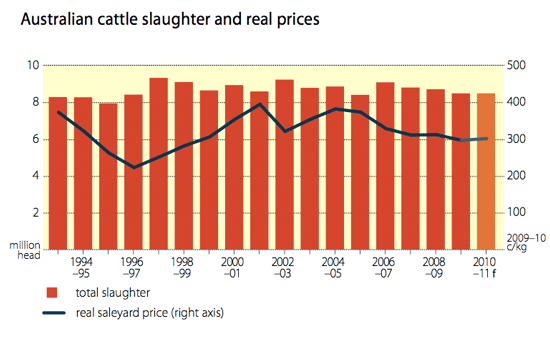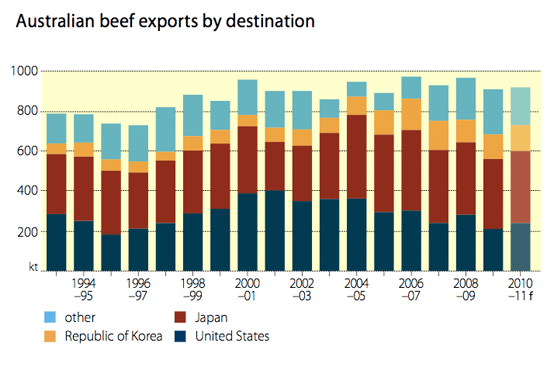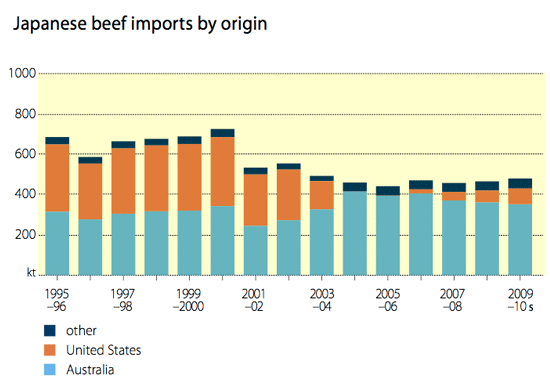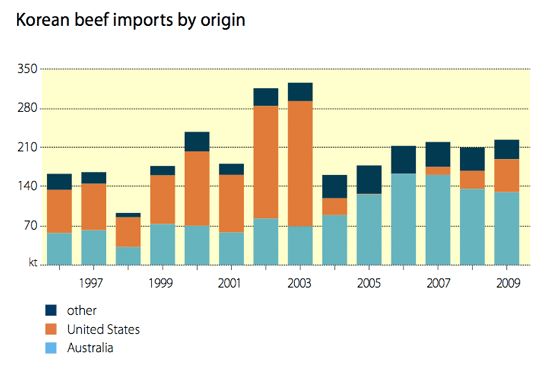



Australian Commodities: Beef And Veal
The Australian saleyard price for beef is forecast to increase by five per cent in 2010–11 to an average of around 301 cents a kilogram (dressed weight), in response to strong domestic restocker demand and improved consumer demand in Australia’s key export markets.Livestock
Beef and veal
However, the outlook for slower income growth in these export markets, particularly the United States and Japan, represents a downside risk to the forecast price, if beef consumption is adversely affected in these markets.
Beef production to increase marginallyAlthough beef cattle slaughter is forecast to be largely unchanged in 2010–11 at 8.5 million head, beef production is forecast to increase by around one per cent to 2.2 million tonnes. Average carcase weights are forecast to increase by around 1 per cent in 2010–11, as a result of favourable seasonal conditions across eastern and parts of northern Australia. Also contributing to higher carcase weights is an expected rise in the number of cattle turned off from feedlots. Cattle turned off from feedlots are generally heavier than cattle turned off from pastures. Between late 2007 and mid-2010, the number of cattle in feedlots increased by around 35 per cent to 791 000 head, in line with stronger demand from Japan and the Republic of Korea. The marbled character of feedlot beef is attractive to Japanese and Korean consumers and demand for Australian beef in these two markets is expected to increase in 2010–11.

Strong restocker demand for cattle has been evident in reduced beef cattle slaughter. In 2009–10, beef cattle slaughter declined by three per cent nationally, as producers expanded herds and increased stocking rates in response to improved seasonal conditions, particularly in regions of southern Australia that were affected by drought in previous years. Cattle slaughter decreased by 14 per cent and 8 per cent in Victoria and Tasmania, respectively. Slaughter in Western Australia also fell by around six per cent.
In contrast, cattle slaughter increased in South Australia in 2009–10, by 22 per cent. Dry conditions in the north of the state in late 2009 encouraged some producers to increase cattle turn-off. More recently, there has been an increase in cattle transported to abattoirs in South Australia from regions in northern Australia. Some of these cattle were originally intended for live export, but were redirected to southern markets after the Indonesian Government enforced restrictions on the import of live cattle.
In 2010–11, export volumes of beef to each of Australia’s major export markets (Japan, the United States and the Republic of Korea) are forecast to increase, despite forecast reductions of exports to other smaller markets. Total beef exports are forecast to increase by only 1 per cent in 2010–11 to 920 000 tonnes.

Australian beef exports to the United States are forecast to increase by 14 per cent in 2010–11 to 240 000 tonnes. Despite an assumed easing of US income growth, import demand for beef is expected to rise as the US beef herd has declined to a historic low. US producers will be unable to increase beef production significantly to meet domestic consumption.
The United States Department of Agriculture has forecast that US beef imports will grow by around 2 per cent in 2010–11 to around 1.3 million tonnes. The scope of the increase will be constrained by limited growth in beef supplies in the major producing countries that are certified to export beef to the United States. This is expected to help underpin US domestic and import prices, and thereby offer Australian exporters the prospect of favourable unit export returns.
The forecast increase in Australian beef exports to the US market in 2010–11 represents a partial recovery of performance compared with 2009–10, when beef exports to the United States declined by 25 per cent to 210 000 tonnes.
Australian beef exports to Japan are forecast to increase by three per cent to 360 000 tonnes in 2010–11. Assumed modest income growth in Japan is expected to lead to higher Japanese beef consumption and increased demand for imports.
The increase in Australian exports to Japan is expected to be constrained by limited export supplies and higher competition from the United States as it recovers market share lost to Australia in the mid-2000s. US beef has been increasing its share of Japanese beef imports by around four percentage points a year since being permitted back into the Japanese market in 2006–07. A weaker US exchange rate relative to the Australian dollar is likely to assist the United States to further increase its share of the Japanese market in the short term. However, Japanese import regulations that apply to countries at risk of bovine spongiform encephalopathy (BSE)—and which restrict beef imported from the US to cattle that do not exceed 20 months of age and not containing any brain or spinal material—will constrain the pace of this increase.

Australian beef exports to the Republic of Korea are forecast to increase by around five per cent to 130 000 tonnes in 2010–11. This is expected to be driven by continued income growth and an expansion of the Republic of Korea’s fast food sector, leading to higher beef imports. As with exports to Japan, the growth in Australian exports to the Korean market will be constrained by limited export supplies and increased competition from US beef. The United States has been increasing its share of Korean beef imports at an average of nine percentage points a year since being permitted back into the Korean market in 2007. In 2009, US beef accounted for around 26 per cent of total Korean beef imports, compared with 69 per cent before the BSE ban on US beef.

Despite increased competition from US beef, Australian exports to the Republic of Korea in 2009–10 increased by 10 per cent to 124 000 tonnes. Australian exports of boneless beef to the Republic of Korea rose by 18 per cent, largely reflecting higher import demand for manufacturing beef, while exports of bone-in beef declined by around one per cent.
Live cattle exports to fallAustralian live cattle exports are forecast to fall by 21 per cent to 720 000 head in 2010–11. This forecast export decline mainly reflects an expected fall in live cattle exports to Indonesia of 30 per cent to around 500 000 head. While live exports to other markets in ASEAN and the Middle East are expected to rise, this will only partially offset the effect of lower exports to Indonesia.
Indonesia is the main market for Australian exports of live cattle, accounting for around 79 per cent of total live exports in 2009–10. Australian live exports to Indonesia have been growing strongly, with shipments almost doubling to 710 000 head in the five years to 2009–10. Strong growth in Indonesia’s beef consumption, along with a significant expansion in feedlots, increased demand for live cattle imports.
However, in early 2010, Australian live exports declined sharply as a result of Indonesia enforcing a weight limit on imported cattle and a reduction in import permits. The Indonesian Government has also enacted a policy to boost local beef production. Cattle originally intended for export to Indonesia from northern Australia, which cannot be redirected to other live export markets, are expected to be diverted to domestic slaughter. However, the numbers are likely to be small compared with total Australian slaughter (at a forecast 8.5 million head in 2010–11).



